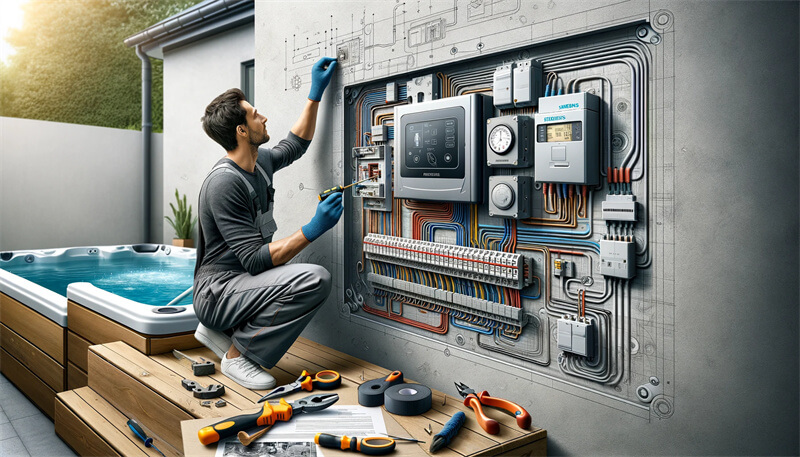Key Takeaways
| Question | Answer |
|---|---|
| What is a Siemens Spa Panel? | A Siemens spa panel is an electrical distribution box designed specifically for safely powering hot tubs, spas, and pools. It includes circuit breakers and often a GFCI (Ground Fault Circuit Interrupter) to ensure protection against electrical shocks. |
| What tools and materials are needed? | Tools: Screwdrivers, wire strippers, voltage tester, pliers, safety gloves. Materials: Siemens spa panel, circuit breakers, grounding wires, screws, conduit, connectors. |
| How do you install a Siemens spa panel? | The process involves preparing the site, mounting the panel, wiring the breakers and connections, grounding the system, and testing for functionality. Detailed steps are provided in this guide. |
| What are common issues during installation? | Common issues include incorrect wiring, inadequate grounding, and circuit breaker tripping. This guide includes troubleshooting tips for these and other problems. |
| How much does it cost? | DIY installation costs include purchasing the panel (around $145) and tools if not already owned. Professional installation can cost between $300 and $500 depending on the complexity of the setup and local labor rates. |
| Is it better to DIY or hire a professional? | DIY can save money if you have the necessary skills and tools, but hiring a professional ensures compliance with local codes and reduces the risk of errors. The guide discusses the pros and cons of each option. |
| What expert tips are available? | Experts recommend double-checking all connections, ensuring proper grounding, and consulting local electrical codes. This guide includes insights from Siemens experts and professional electricians to ensure a safe and effective installation. |
1. Introduction
Welcome to our comprehensive guide on installing a Siemens spa panel. At ControlNexus, we are dedicated to providing top-tier Siemens industrial control products, including Siemens PLCs, HMIs, and inverters. This guide will walk you through the essential steps for installing a Siemens spa panel, ensuring you have a safe and efficient setup for your spa or hot tub.
2. What You Need to Know About Siemens Spa Panels
Types of Siemens Spa Panels
Siemens offers a variety of spa panels, each tailored to different needs and specifications. Here are some popular models:
| Model | Amps | GFCI | Spaces | Circuits | Outdoor | Price |
|---|---|---|---|---|---|---|
| Siemens W0408L1125SPA50 | 125 | 50 | 4 | 8 | Yes | $145.47 |
| Siemens P1224L1125CU | 125 | 20-60 | 12 | 24 | Yes | $125.00 |
Key Features
- GFCI Protection: Essential for preventing electrical shocks by interrupting the circuit when a fault is detected.
- Outdoor Suitability: Weatherproof designs ensure safe and reliable operation in outdoor environments.
- Circuit Breaker Compatibility: Designed to work seamlessly with Siemens circuit breakers for robust power distribution.
Benefits
- Safety: Enhanced protection against electrical hazards, particularly in wet environments.
- Reliability: Siemens panels are known for their durability and dependable performance.
- Ease of Use: Straightforward installation and maintenance make Siemens spa panels a favorite among DIY enthusiasts and professionals alike.
3. Tools and Materials Needed
Before you begin the installation process, gather the following tools and materials:
Tools
- Screwdrivers: Phillips and flathead.
- Wire Strippers: For preparing wires.
- Voltage Tester: To ensure no live wires during installation.
- Pliers: For gripping and twisting wires.
- Safety Gloves: To protect against electric shock and sharp edges.
Materials
- Siemens Spa Panel: Choose the model that fits your needs.
- Circuit Breakers: Compatible Siemens breakers.
- Grounding Wires: For safety grounding.
- Screws and Anchors: For mounting the panel.
- Conduit and Connectors: To protect and route wiring.
4. Step-by-Step Installation Guide
Preparation
- Safety First: Turn off the main power supply to ensure a safe working environment.
- Site Preparation: Select a suitable location for the panel, preferably near the spa but away from water sources.
- Gather Tools and Materials: Ensure all necessary tools and materials are within reach.
Mounting the Panel
- Position the Panel: Hold the panel against the wall and mark the mounting points.
- Drill Holes: Use a drill to make holes for the mounting screws.
- Secure the Panel: Attach the panel to the wall using screws and anchors, ensuring it is level and firmly in place.
Wiring the Panel
- Connect the Grounding Wires: Attach the grounding wires to the grounding bar in the panel.
- Install the Circuit Breakers: Snap the breakers into the panel, ensuring they are securely connected to the bus bars.
- Wire the Breakers: Connect the incoming power wires to the main breaker and the spa wires to the appropriate breakers.
Final Steps
- Double-Check Connections: Ensure all wires are securely connected and there are no loose ends.
- Restore Power: Turn on the main power supply and test the spa panel to ensure it is functioning correctly.
- Test GFCI: Press the test button on the GFCI breaker to ensure it trips and resets correctly.
5. Common Installation Issues and How to Fix Them
Troubleshooting Tips
- Circuit Breaker Tripping: Check for overloads or short circuits. Ensure the wiring is correct and there are no exposed wires.
- Inadequate Grounding: Double-check all grounding connections and ensure the grounding wire is properly attached to the grounding bar.
- No Power to Spa: Verify that all breakers are properly installed and the main power supply is turned on.
FAQs
- What should I do if the breaker keeps tripping? Ensure there is no overload on the circuit and all connections are secure.
- How do I know if the GFCI is working? Press the test button; if it trips, it is functioning correctly. If not, it may need replacement.
6. Cost Analysis: DIY vs. Professional Installation
DIY Costs
- Panel and Materials: Approximately $145 for the panel plus additional costs for tools and materials.
- Time: Typically 2-4 hours depending on your experience and the complexity of the installation.
Professional Installation Costs
- Labor Costs: Between $300 and $500, varying by location and complexity.
- Pros: Ensures compliance with local electrical codes and reduces the risk of errors.
- Cons: Higher upfront cost compared to DIY.
Pros and Cons
- DIY: Cost-effective if you have the skills and tools. However, it requires careful attention to safety and detail.
- Professional: Higher cost but ensures a safe and code-compliant installation, minimizing potential risks.
7. Expert Tips and Advice
Professional Insights
Experts at Siemens and professional electricians offer invaluable advice for a successful installation. Here are some key tips:
- Double-Check All Connections: Ensuring that all connections are secure and correctly made can prevent future issues and potential hazards.
- Use Correct Wire Gauges: Using the appropriate wire gauge for the amperage load is crucial for safety and efficiency. Consult local electrical codes or a professional if unsure.
- Proper Grounding: Always ensure the panel is properly grounded. This not only protects against electrical shocks but also helps in stabilizing the system.
- Follow Manufacturer Instructions: Always adhere to the installation guidelines provided by Siemens. This ensures compatibility and optimal performance.
Best Practices
Maintaining your Siemens spa panel involves regular inspections and timely updates. Here are some best practices:
- Routine Inspections: Periodically inspect the panel for signs of wear, corrosion, or damage. Regular checks can help in the early detection of potential issues.
- Keep Documentation: Maintain a record of all installations and modifications. This can be useful for troubleshooting and future maintenance.
- Stay Updated with Codes: Electrical codes can change. Stay informed about local regulations to ensure your installation remains compliant.
8. Conclusion
Installing a Siemens spa panel is a crucial step in setting up a safe and efficient spa or hot tub environment. By following this comprehensive guide, you can ensure a successful installation whether you choose to DIY or hire a professional. Remember, safety is paramount, and proper installation can prevent many potential hazards.
For further assistance or to explore more Siemens products, visit our Siemens PLCs, Siemens HMIs, and Siemens Inverters pages.
9. FAQs
Frequently Asked Questions
Q: What should I do if the breaker keeps tripping?
- A: Ensure there is no overload on the circuit, check for short circuits, and verify that all connections are secure. If the problem persists, consult a professional.
Q: How do I know if the GFCI is working?
- A: Press the test button on the GFCI breaker. If it trips and can be reset, it is functioning correctly. If not, it may need replacement.
Q: Can I install a Siemens spa panel myself?
- A: Yes, if you have basic electrical knowledge and follow the safety guidelines provided. However, if you are unsure, it is recommended to hire a professional to ensure compliance with local electrical codes.
Q: What tools do I need for installation?
- A: You will need screwdrivers, wire strippers, a voltage tester, pliers, and safety gloves. Ensure all tools are insulated and in good condition.
Q: How often should I inspect my spa panel?
- A: Regular inspections every 6 months are recommended to check for wear, corrosion, and secure connections.
For more detailed information and further assistance, visit our Contact page.



